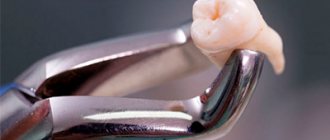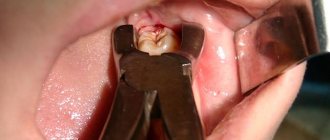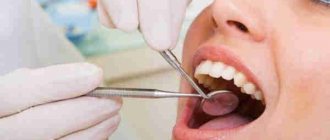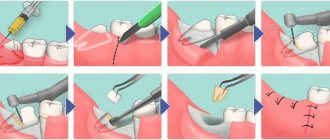Any manipulation of teeth is a traumatic process that involves interference with the tissue structure. After this, the person may sometimes feel pain and discomfort when chewing or drinking hot or cold drinks. Therefore, after visiting the dentist, the question often arises whether a tooth can hurt after nerve removal and how long it lasts. In the absence of complications, all discomfort disappears after a few days.
Increasing pain and the appearance of signs of inflammation require urgent medical attention. The dental clinic’s specialists will provide qualified assistance and help you quickly return to your normal lifestyle.
Content:
- Can a tooth hurt after nerve removal?
- When to sound the alarm
- Reasons why a “dead” tooth hurts
- How to deal with pain in a pulpless tooth
Nerve extraction is a fairly common dental procedure.
It is not complicated. The dentists worked it out to the smallest detail. Most often, the patient does not even experience any discomfort. After all, highly effective anesthetics are used during depulpation. After removal of the nerve, the tooth may hurt for two to three days. Then, normally, the pain disappears on its own.
If pain symptoms persist longer, it is recommended to visit the doctor again. It is possible that previous treatment of pulpitis led to complications.
Is it possible to cure a tooth on your own?
Remember: it is impossible to cure a tooth on your own, without the help of a specialist!
All means - medications, folk recipes - have only a temporary, disinfecting and alleviating effect. To get rid of pain, you need to make a correct diagnosis and eliminate the cause, and this can only be done by a dentist in a specialized medical institution using modern diagnostic and treatment technologies. Recommendations for self-treatment of a tooth under a filling can lead to the development of complications even faster.
Can a tooth hurt after nerve removal?
The pulp is a thin bundle of nerves, blood vessels and ligaments. It fills the entire internal cavity of the tooth. The condition and sensitivity of the unit, the strength of the enamel layer and even the color of the enamel depend on it.
Due to advanced inflammation, damage to the pulp zone occurs. Then pulpitis develops. Subjectively, a person feels it as an acute pain that appears during temperature changes and mechanical impact. To prevent further spread of the inflammatory process, the doctor removes the inflamed pulp, cleans the dental canals and covers them with filling material.
After depulpation, the tooth stops responding to stimuli. That is, in fact, he should not be sick. However, people often come to the dental clinic complaining of pain in the pulpless unit. With what it can be connected?
Incorrectly performed treatment
Poor quality materials and violation of treatment technology also cause pain. Reasons for such complications include:
- the channels are not completely cleaned;
- the nerve was partially removed;
- cavities remain under the filling material, leading to tissue destruction and the development of inflammatory processes;
- During filling, the material is moved beyond the apex of the root canal;
- The doctor did not notice any branches or lateral additional channels during treatment.
When to sound the alarm
Mild soreness after nerve tissue removal is normal. After all, the canals are expanded, their shape is changed in order to be densely filled with a filling compound.
Mild discomfort that persists in the first few days is what doctors call post-filling pain. It does not require special treatment. If necessary, the patient can take painkillers.
During the depulpation procedure, microtraumas are inevitable. The tissues need to be given time to recover. Within two or three days there will be no trace of post-filling discomfort.
This is what the symptoms look like, indicating that the regeneration processes are not going according to plan:
- the pain persists after five to seven days, it is sharp, severe, and interferes with leading a normal lifestyle;
- analgesics do not relieve symptoms immediately and for a short time (sometimes they are completely useless);
- body temperature is increased;
- the gums in the area of the problem unit become inflamed and swollen;
- headache;
- the pain spreads to neighboring teeth, sometimes it is difficult to understand which zone is its source.
With these signs, you need to determine the cause of the problem as soon as possible. To do this, you should seek medical help. The doctor will conduct a diagnosis and tell you what to do to speed up regeneration.
Prevention
You should not think that a tooth with a removed nerve, deprived of blood supply, will relieve you of dental problems - you have already seen this. On the contrary, such teeth are problematic and therefore require more careful care. They are susceptible to any dental diseases - perhaps, except for pulpitis.
- The main means of prevention is thorough oral hygiene 2 times a day using a brush, dental floss, and mouthwash.
- A balanced diet containing enough vitamins and minerals will help keep your teeth longer.
- Regular visits to the dentist - at least once every 3 months - will make it possible to recognize the problem at the initial stage.
And remember: the best prevention of toothache is not to let the tooth need to be depulped, because the likelihood of subsequent complications is very high.
Author: Elena Kopylova Dentist-endodontist. Work experience more than 12 years.
The information is for reference only. Before treatment, consultation with a doctor is necessary.
Reasons why a “dead” tooth hurts
Most often, the complication is associated with poor quality work by the dentist. It is very important to treat the canals correctly. There should be no air pockets left in them. Otherwise, very soon pathogenic microorganisms will penetrate there and begin to actively multiply.
Among the most common causes of pain after depulpation:
- Incomplete closure of dental canals. Such a medical error does not make itself felt immediately. At first the patient enjoys a healthy smile, but at some point the situation changes. Sometimes poor-quality filling results in the formation of a cyst or granuloma. These are quite dangerous complications.
- The installed filling extends beyond the boundaries of the root. Painful symptoms occur when pressure is applied to the treated area. Excess paste puts pressure on the jaw bone and irritates it. As a result, the inflammatory process is activated. The greater the volume of excess material, the more pronounced the negative symptoms.
- The presence of a fragment of a medical instrument at the root. Fortunately, this doesn't happen often. The products used by the doctor during depulpation are very thin. They need to be able to manage. It is unacceptable to put too much pressure on them. Any inaccurate movement and the lower part of the instrument remains in the channel. By the way, this can also happen due to the patient’s fault if he is constantly fidgeting and closing his mouth when this is strictly forbidden. Until the fragment is removed, the pain will not go away.
- Perforation or disruption of the integrity of the tooth root wall. It is a consequence of careless use of endodontic equipment. Due to the action of the anesthetic, a person may not feel that a transformation has occurred. But this state does not come without a trace. It requires mandatory correction. Through the artificial cavity in the root, the filling agent can penetrate to the border of the jaw bone. Then the latter will become inflamed.
- Personal intolerance to the embedded material. We are talking about an allergic reaction. You can never know in advance how a particular person’s body will react to antiseptics or a filling. With allergies, soon after depulpation the patient begins to feel aching pain. Burning and redness of the gum mucosa is also possible. In case of a severe allergic reaction, the eyes become watery and nasal breathing becomes difficult. Body temperature may also increase.
Any of the above reasons is a reason to get dental care as soon as possible. By postponing a visit to the doctor until later, a person risks his health.
What to do if your tooth hurts after root canal cleaning
There can be many answers to the question of why a tooth hurts after root canal cleaning. For this reason, it is very important to pay attention to the characteristics of the individual patient’s body.
If you notice the first signs of the inflammatory process described in this material, you should consult a doctor as soon as possible.
The dentist carries out several basic actions:
- Collecting an anamnesis, taking into account the characteristics of the patient’s condition, the nature of the pain, medications taken, and personal characteristics of the body.
- X-ray of the affected tooth, examination of the condition of the gums, canals, assessment of the quality of the work performed.
- Opening the seal, re-cleaning, using disinfectants.
- Prescribing the patient a course of anti-inflammatory drugs and other medications.
Timely actions help to significantly reduce potential harm to the human body and ensure that the tooth can be saved.
How to deal with pain in a pulpless tooth
You'll have to sit in the dentist's chair again - there's no way around it. Repeated treatment usually consists of the following stages:
- Inspection and diagnostics to determine the cause of the problem. Most often, it is very easy to get answers to all the questions that arise - the patient is asked to take an x-ray. It shows the condition of the roots and the quality of canal filling. Also, from the image you can recognize the fragments of instruments forgotten by the would-be doctor. If radiography does not reveal any abnormalities - the unit is healthy, like its neighbors - the development of allergies can be assumed. Then the patient is asked to donate blood for allergens.
- Eliminating the cause of pain. Most often, to do this, the doctor removes the previously installed filling compound, opens the cavity of the dental canal and corrects the mistakes made. If the canals were processed poorly, they are sealed again. If the material extends beyond the top, the excess is removed. If there is a perforation on the face, it is covered with a special material. If there is debris, it is removed. In the case of allergies, repeated treatment must be carried out, but with the use of other medications.
- Canal filling. As soon as the negative influence of the provoking factor is eliminated, the doctor will close the dental canals and carious cavity. After this, he will conduct x-ray diagnostics again to make sure that everything is normal with the patient.
It is important to understand that even after repeated treatment, pain symptoms may still persist for some time. This is due to the occurrence of regeneration processes. You should be patient and strictly follow all medical prescriptions. If the doctor has prescribed antibiotics or some kind of anti-inflammatory drug, you must take it.
How to fix the problem
The treatment method is determined by the cause of the inflammatory process and pain. Depending on this, the following ways to resolve the problem are possible:
- For trigeminal neuralgia, anticonvulsants and antispasmodics are prescribed.
- If the nerve is not completely removed, depulpation is performed again.
- If there is an allergy or perforation of the tooth roots, a new filling is installed. The integrity of tissues is restored with the help of modern medications.
- If there is a purulent formation (periodontitis), it is opened, cleaned and treated with antiseptics.
If a piece of instrument is found in the canal, it should be removed as quickly as possible. To do this, the doctor must have sufficient experience and knowledge.
Low quality filling material
Today, almost all modern clinics use exclusively composite light fillings. However, just a few years ago, you could walk out of the dentist's office with a metal amalgam in your tooth or a regular cement filling. If you still have such “old” fillings, then there is a high probability that the tooth tissues hurt precisely because of this material. Over time, such compositions may lose their properties, crack, and dry out. Sometimes a filling, having greater hardness than tooth enamel, can destroy the crown. Even keeping a filling in place for a long time does not guarantee the health of this organ and a positive result of treatment.
Allergic reaction
The inflammatory process in tooth tissues, as is known, can be provoked by both an infectious factor and an allergic one. Tooth tissue can sometimes produce this effect in response to medications or interaction with a filling. Although composite light fillings are characterized by minimal allergic properties, individual reactions of human tissues sometimes give such a result.
This problem can be solved quite simply: the filling with the harmful allergen is removed, and a composite with a different chemical composition is installed in its place. For the future, it is advisable for you to remember which particular filling caused a negative reaction in your body, so that the next time you visit another dentist, you can warn him about this feature.
Installing a temporary filling
A certain method of treatment, when a temporary filling is installed, involves placing a medicinal substance at the bottom of the carious cavity, which strengthens and nourishes thinned dentin tissue. Or it could be a drug that destroys the nerve tissue of the tooth. Its effect often produces a painful reaction from the pulp chamber, as a result the filling seems to hurt. Therefore, you should not perceive such discomfort as a treatment error. At the appointed time, go to your dentist, who will remove the temporary filling and install a permanent photopolymer.
If the pain becomes unbearable, you need to take a good dose of analgesics. As a last resort, it is allowed to open a temporary filling at home, remove the medicine from the carious cavity and cover the hole with a temporary tampon. A visit to your dentist within 24 hours is required.
In order to never find yourself in a situation of repeated treatment, you need to choose your dentist wisely. Pay attention to the reviews of your friends, the level of qualifications of the specialist and the general experience of medical practice. For example, the LeaderStom network of clinics takes the issue of personnel selection very seriously: all dentists have the most prestigious professional titles and regalia, gained through successful work experience. This gives an almost 100% guarantee of high-quality, competent dental therapy.
How to prevent pain and complications
Regardless of the field of medicine, doctors agree with a simple statement - it is much easier to prevent complications from developing at all than to treat them. There are a few simple recommendations that you should follow:
- Pay close attention to who is performing the operation on you. In our clinic, the task is performed by experienced surgeons who are well aware of all the features of the process. This ensures that mistakes are eliminated - the canal is filled correctly, and there are no fragments or dental instruments left inside.
- If you have previously had an allergy to any analgesics or anti-inflammatory drugs, tell your doctor.
- Don't put off visiting your doctor. The longer you leave a tooth untreated, the greater the risk of numerous potential complications.
- Ask how long the tooth hurts after root canal cleaning in your specific case. The doctor can make a prognosis based on information about the health status of a particular patient.
Also remember that if after cleaning the canals you have any signs of inflammation, you need to see a doctor as soon as possible. It is strictly forbidden to use self-medication, drugs without recommendation, or folk remedies. All this can only make the situation worse.
Symptoms
Most often, painful sensations occur during chewing or eating hot or cold food. Some patients complain of almost constant, aching or throbbing pain.
The inflammatory process can develop rapidly. In this case, the pain is usually sharp and severe. May be accompanied by swelling of the gums and swelling of the face. Sometimes the inflammation lasts for years, and since the patient does not experience severe pain, he delays the visit to the dentist, aggravating the situation.











